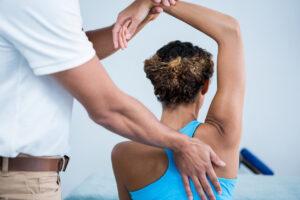In honor of Halloween weekend coming right around the corner, we thought it was time to uncover some of the spookiest fitness myths we’ve heard our patients say or ask about in our clinics.
Physical fitness is a topic that’s often clouded by misconceptions. With so much information available, it can be challenging to separate fact from fiction. In this haunting post, we’ll debunk seven common physical fitness myths to help you make informed decisions about your health and wellness this Fall season.
Top Fitness Myths Debunked
Myth 1: No Pain, No Gain
One of the most pervasive (and frightening) myths in the fitness world is the belief that if you’re not in pain, you’re not making progress. While some level of discomfort is expected during a challenging workout, pain is not the goal. Pushing yourself to the point of pain can lead to injuries, overtraining, and burnout.
The truth is that progress in fitness can be achieved through gradual and consistent effort. Pain is not a reliable indicator of a successful workout. Instead, focus on making steady improvements, listening to your body, and avoiding excessive strain.
Myth 2: Spot Reduction for Fat Loss
Many people believe that targeting specific areas of the body with exercises will lead to localized fat loss. In other words, if you want to lose belly fat, you should do endless sit-ups. Unfortunately, spot reduction is a myth.
Fat loss occurs throughout the body, and it’s influenced by factors like genetics and overall calorie balance. To lose fat in a specific area, you need to reduce your overall body fat through a combination of a balanced diet and full-body workouts. While targeted exercises can help tone specific muscles, they won’t magically melt away fat in those areas.
Myth 3: Cardio Is the Best Way to Lose Weight
Cardiovascular exercise, such as running or cycling, is often associated with weight loss. While these types of aerobic exercise can be an effective way to burn calories and improve cardiovascular health, it’s not the only option. Strength training or resistance training, which includes activities like weightlifting, can also aid weight loss by increasing muscle mass, which in turn raises your metabolic rate.
A balanced approach that includes both cardio and strength training is generally the most effective way to achieve sustainable weight loss, build lean muscle, and improve your overall fitness.
Myth 4: You Can Out-Exercise a Poor Diet
This fitness myth is a common and spooky pitfall for many individuals. While exercise is essential for health, you cannot “outrun” a bad diet. Nutrition plays a pivotal role in achieving your fitness goal. Consuming excessive calories or a diet high in processed and unhealthy foods can counteract the benefits of exercise.
A combination of a balanced diet and regular physical activity, inclusive of some strength training, is the most effective way to achieve and maintain a healthy weight. Focus on nourishing your body with whole, nutrient-dense foods, and you’ll see better results from your workouts!
Myth 5: More Exercise Is Always Better
While exercise is undoubtedly beneficial, overtraining can be harmful. Some people believe that working out for hours every day will lead to faster results. In reality, excessive exercise can lead to burnout, injuries, and decreased performance.
The key is finding a balance that works for you. Aim for a consistent exercise routine that includes rest days to allow your body to recover. Recovery is an essential part of the fitness equation, as it helps prevent injuries and ensures you can maintain a long-term commitment to a healthy lifestyle.
Myth 6: Supplements Are the Secret to Success
The supplement industry is booming, and many products claim to be a shortcut to fitness success. While some supplements can be beneficial, they are not a magic solution. The foundation of your fitness journey should be a balanced diet and regular exercise. Supplements should complement, not replace, these core principles.
Before taking any supplements, consult with a healthcare professional to determine if they are appropriate for your specific needs. In most cases, whole foods should be your primary source of nutrients.
Myth 7: You Must Be Young to Be Fit
Age is just a number when it comes to fitness! It’s never too late to start or maintain a fitness routine. While it’s true that physical capabilities may change with age, staying active and making healthier lifestyle choices can help you maintain and improve your fitness at any stage of life.
In fact, exercise can be particularly beneficial for older adults, as it can improve balance, reduce the risk of chronic diseases, and enhance overall well-being. Don’t let the myth that fitness is only for the young deter you from taking steps toward a healthier, more active life.
Don’t Spook Your Local Physiotherapist!
Dispelling the common fitness myth is essential for making informed decisions about your health. Remember that fitness is a lifelong journey, and there are no shortcuts.
A balanced approach that combines regular exercise—inclusive of weight training/lifting weights—a healthy diet, and sensible supplementation (if necessary) is the key to achieving your fitness goals.
So, whether you’re young or old, new to fitness or a seasoned pro, focus on making informed choices and enjoying the journey toward a healthier, more active life. Struggling with an injury or just looking for a tune-up? Schedule a same-day appointment at any of our Synergy Rehab locations! We’ve got your back.








